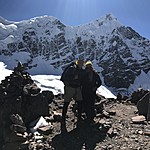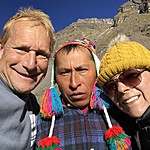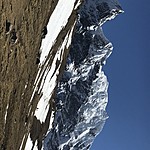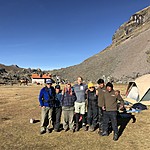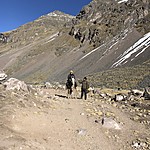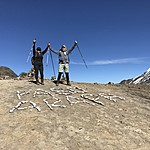
Ausangate Camping Trek

Note: The 5-day group departures listed above include the trekking portions of the itinerary below (days 3-7). Our specialists can help you plan the rest of the trip around your chosen departure date.
Planning a trek? Let one of our trusted local travel specialists help you plan your trip.
Highlights
- Visit traditional herding villages nestled in the mountains
- Soak in the hot springs of Upis and Pachanta
- See a stunning waterfall and three different azure lakes
- Climb the harsh, snowy 5050m Campa pass
- Get a chance to spot endemic wildlife such as vizcachas and Andean foxes
Overview
| Trek fast facts | |
|---|---|
| Trek Duration | 5 days |
| Max. elevation | 5,200m (17,060 ft) |
| Start/finish | Tinqui/Tinqui |
| Difficulty | Challenging |
| Best season | Late Spring/Summer/Early Fall |
| Trek-style | Camping |
Ausangate (6,384m) is the highest Apu (Inca sacred mountain) in Peru, revered by the Inca as the origin of life because its glaciers melt into the region’s vital rivers. Centuries ago, Inca pilgrims would hike the trails of Ausangate to pay homage, make offerings, and seek good fortune.
Today, these trails are the starting points of our 5-day trek. The area is now home to a few remote pastoral communities, which make a living herding alpacas and llamas. We will have opportunities to visit them at the beginning and end of the trek. These herders preserve a traditional way of life and have adapted to high altitudes. However, these altitudes may be problematic for first-time mountain trekkers, who will need time to acclimatize.
This trek is most appropriate for seasoned trekkers or those in good physical condition. You will need to cross four tough passes: Arapa pass (4,800m), Apuchata pass (4,900m), Palomani pass (5,200m), then finally Campa pass (5,050m). Additionally, the weather will be colder than more typical Peru locations. There won’t be Inca architecture or ruins to see, but the surreal natural scenery on the trek will make up for it.
Chat with a local specialist who can help organize your trip.
Brief itinerary
| Day | Destination | Altitude | Overnight |
|---|---|---|---|
| Day 1 | Arrival in Lima | 1,550m | Lima |
| Day 2 | Arrival in Cusco, Exploring the City | 3,300m | Cusco |
| Day 3 | Ausangate Trek Day 1/5: Trek to Upis | 4,400m | Upis |
| Day 4 | Ausangate Trek Day 2/5: Trek to Jatun Cupacocha | 4,800m | Jatun Cupacocha |
| Day 5 | Ausangate Trek Day 3/5: Trek to Ausangate Base Camp | 5,200m | Ausangate Base Camp |
| Day 6 | Ausangate Trek Day 4/5: Trek to Pachanta | 5,050m | Pachanta |
| Day 7 | Ausangate Trek Day 5/5: Pachanta Tinqui, Return to Cusco | 4,237m | Cusco |
| Day 8 | Departure |
Detailed itinerary
Day 1: Arrival in Lima
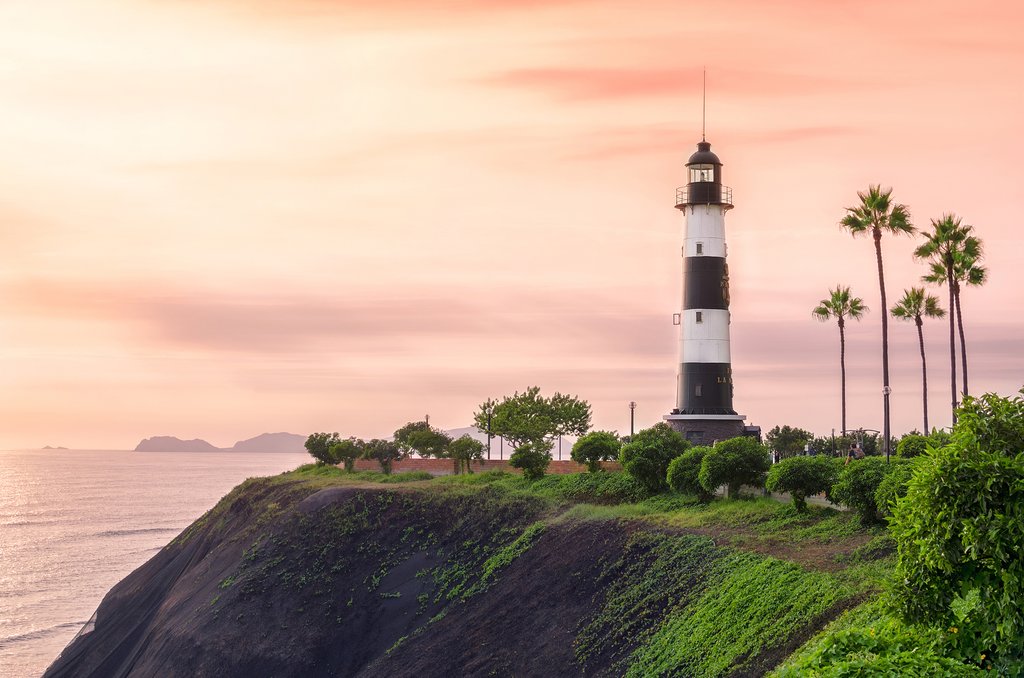
¡Bienvenidos! Welcome to Lima, Peru's largest city and central metropolitan hub, and home to one-third of the country's population. Located at the site of a pre-Columbian indigenous Ychsma settlement, which was conquered by the Inca empire in the 15th century and later by the Spanish conquistadores, Lima has a fascinating history and a diverse mix of cultures. Amerindian, European, Afro-Peruvian, and Asian—especially Chinese and Japanese—influences make Lima a dynamic and exciting city to explore.
Lima's breezy location on the Pacific Ocean and mild desert climate make it the perfect city for exploring on foot. Head downtown to mingle with locals, stretch your legs, and grab a bite to eat in one of the many award-winning restaurants.
Suggested activities include:
-
Explore the historic center of Lima, a UNESCO World Heritage Site packed with fascinating Spanish architecture. Start with a scenic tour of the colonial downtown, which emanates from the main square. Stroll over to the 16th-century Cathedral, which took 80 years to construct and was built in the grandiose style of the Spanish Empire.
-
Visit the Casa Aliaga, a colonial mansion granted by chief conquistador Francisco Pizarro to Jerónimo de Aliaga, one of his captains, in 1535. This is the only house from that era that still belongs to the same family.
- Stroll around the Pueblo Libre district to the privately owned Larco Museum of pre-Columbian art, housed in a beautifully restored viceregal mansion built over a 7th-century pre-Columbian pyramid. The museum boasts a vast pre-Colonial collection of gold and silver artifacts, as well as pieces of erotic art.
- In the evening, head to the eclectic "Love Park" in the upscale coastal district of Miraflores, where you can admire a huge kissing statue and beautiful mosaic walls. The park is built on the cliffs of Chorrillos and is a perfect place to enjoy a spectacular sunset over the Pacific.
- Enjoy a nightcap at an open-air cafe or restaurant in the diverse Miraflores neighborhood.
Day 2: Arrival in Cusco, Exploring the City

Head to the Lima airport for your transfer flight to Cusco. This ancient city is the former capital of the Inca empire, which reigned from the 13th to 16th centuries after conquering the Killke settlement on the same location.
Remember: you will be 11,000 feet (3,000 m) above sea level, so take it easy and remember to drink lots of water. Since Cusco was designed by the Incas as a city for walking, start your exploration of the narrow stone alleyways on foot. Take a walk through the plaza — if the weather is beautiful, it's a perfect place to sit on a balcony and have a cup of coca tea while adjusting to the elevation.
Suggested activities include:
-
Visit the Coricancha, also known as "The Temple of the Sun." The temple was built by the Incan Emperor Pachacutec (1438 - 1572), and after the arrival of the Spaniards became the basis for the construction of the Santo Domingo Convent.
-
See the Cathedral, the most imposing monument in the central Plaza de Armas and a repository for Cusco's colonial art. Its construction lasted for almost 100 years, beginning in 1560 and ending in 1654.
-
Walk to Sacsayhuamán and next-door Quenqo, both archaeological complexes used mostly for religious and agricultural rituals, located 2.5 miles (4 km) from the city of Cusco. Built by the Killke people, Sacsayhuamán is a marvel of ancient architecture, a monolithic fortress built from giant blocks of stone, the origins and assembly of which remain a mystery.
-
Discover the elaborate Puca Pucara ruins—an architectural complex of alleged military use with multiple plazas, baths, aqueducts, walls, and towers. It is believed that the entourage of the Incan emperor used it while he stayed at Tambomachay, the elaborate estate and baths nearby.
-
Explore San Blas, an old bohemian quarter famous for its picturesque white walls, blue doors, and creative artisan community.
-
Experience the legendary Mercado Central de San Pedro, a large and diverse market famous for its mouth-watering fruit juices, home-style meals, medicinal herb stalls, and rows of various meats, breads, vegetables, and other necessities.
- Eat lunch at a local Peruvian restaurant and sample local flavors and cooking techniques—crackling pork, pickled vegetables, seasonal flavors, bread baked in earthen ovens, roasted vegetables, and sweet donuts make for a delicious and filling meal.
Day 3: Ausangate Trek Day 1/5: Drive from Cusco to Tinqui, Trek to Upis

Arrive at the village of Tinqui (3,800m) after a 3-hour morning drive, and prepare to begin your trek. Observe local farmers and herders with their alpaca flocks, and meet your crew of mules and their handlers. Then, start heading towards the Upis (4,400m) campsite.
The first day of trekking is relatively smooth, passing through hilly puna grasslands where you may encounter vizcachas (rabbit or chinchilla-like rodents), condors, or foxes. Once you get to Upis, you will be rewarded with views of the Ausangate glaciers rising above the site. End the day with a refreshing soak at the nearby hot springs.
Day 4: Ausangate Trek Day 2/5: Trek from Upis to Jatun Pucacocha

Get ready for a day of more intense trekking. From camp, you will climb directly through the Arapa pass (4,800m) before reaching the Uchuy Pucacocha (“little red lake”), one of the several dazzling mountain lakes in the region. Marvel at its waterfalls, and continue onwards to Jatun Pucacocha (“big red lake”), where you will camp along its shores.
Day 5: Ausangate Trek Day 3/5: Trek from Jatun Pucacocha to Ausangate Base Camp
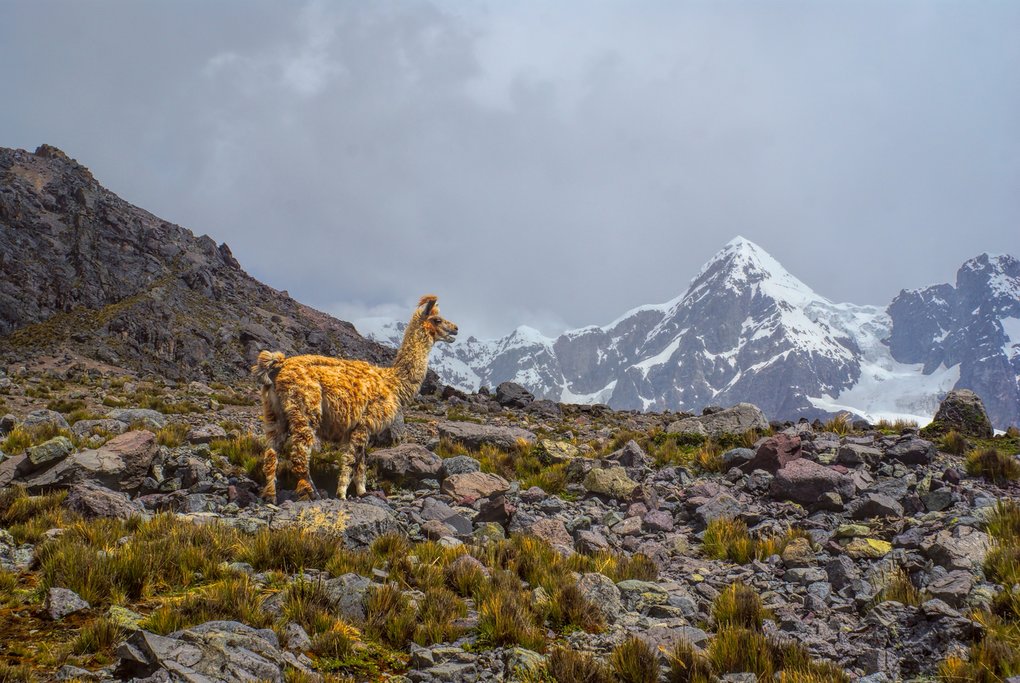
You will cross two different passes today, although the steady ascents will assist you in the process. The Apuchata pass (4,900m) comes first, followed by the descent to turquoise lake Ausangatecocha.
Afterward, you will reach the far side of Ausangate and hike the second pass, Palomani (5,200m). Finally, trek through the mountain-climbers’ base camp to your own campsite (4,510m). Here, amidst the highlands meadows and icy moraines, you will spend another night.
Day 6: Ausangate Trek Day 4/5: Trek from Base Camp to Pachanta

The last day of pass crossing begins with a tranquil walk to another lake, Ticllacocha. Along the way, more vizcachas and perhaps even rare camel-like vicuñas may be roaming the green grasses of the valley.
Then, rise up for your final challenge: Campa pass (5,050m). Once you tread over the snowy scree on the slopes, past the adjacent glaciers, all you have to do is descend. Set up camp for the last time at Pachanta (4,360m), and rest in the soothing waters of the site’s hot springs.
Day 7: Ausangate Trek Day 5/5: Trek from Pachanta Tinqui, Drive back to Cusco

After one last short hike, you will back at the Tinqui trailhead (4,237m). Bid farewell to the muleteers, and ride the bus back to Cusco after a spectacular journey.
Day 8: Departure
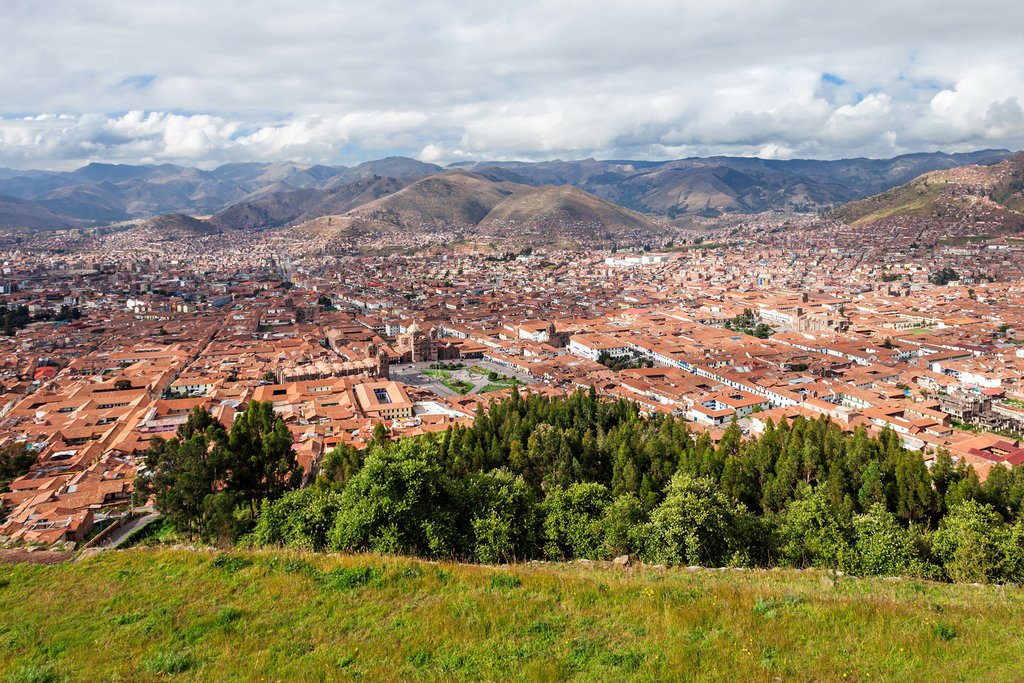
Today is your last day in Peru! You will be met at your hotel for a transfer to the airport, where you will connect to your departure flight. ¡Buen viaje!
Best Season
Undertaking the Ausangate trek is best between May and September, during the dry season. Like most other treks in the region, hiking during the rainy season poses a greater challenge due to weather conditions. This is especially true for Ausangate, as due to the high altitudes, snow instead of rain will frequently fall.
However, despite the milder weather in the dry season, the area will still be relatively cold, so come prepared with layers. There should be no concerns about crowds and peak seasons, as the region is not as tourist-oriented as other more accessible sites such as Machu Picchu.
Ready to start planning your trek?
Get connected to a knowledgeable trekking specialist in Peru who can help you start organizing your trek. Click here to start planning.
Note: The 5-day group departures listed below include the trekking portions of the itinerary above (days 3-7). Our specialists can help you plan the rest of the trip around your chosen departure date.

